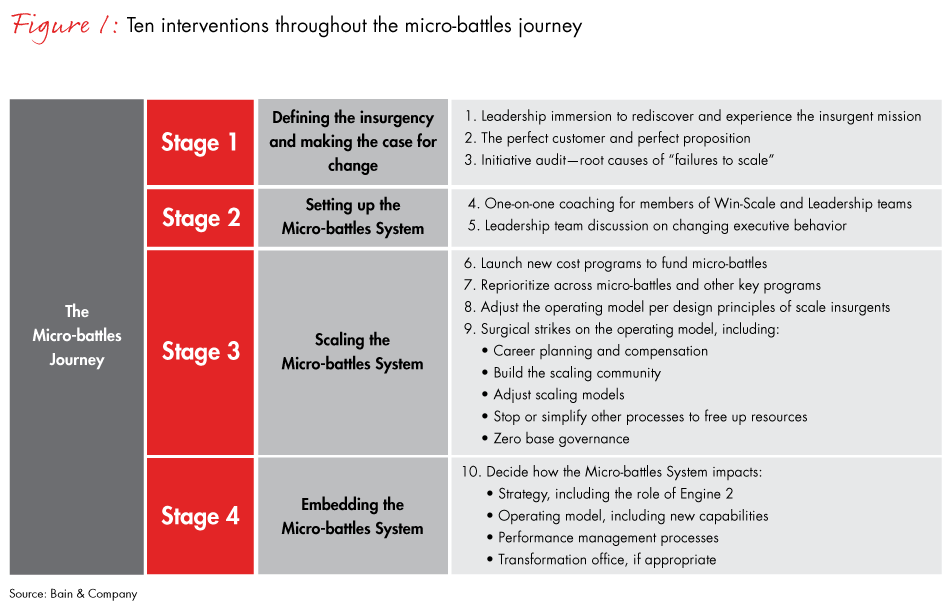Founder's Mentality Blog

You’re frustrated. Your company is surrounded by insurgents, who are constantly innovating, disrupting and occasionally picking off some of your most important customers. Yet, internally, there’s no sense of urgency. Meetings come and go. Initiatives are launched with great fanfare, only to repeatedly underperform, yet never quite die. You lose top recruits that hint you’re yesterday’s company, but these losses are explained away. Some longstanding customers drift away, but again, the organization produces perfectly satisfactory explanations.
You decide to shake things up. You like this Founder’s Mentality® thing, and you like the idea of becoming a scale insurgent. You recognize this demands you rediscover your original insurgency, your frontline obsession and your owner mindset. And you’re compelled to launch micro-battles, to rediscover the art of getting things done. You’re tired of the complacency that surrounds you and love the idea of a minirevolution to wake everyone up. So you launch micro-battles and “trust the system”—your micro-battle teams will work according to the Win-Scale cycle and your leadership team will manage the portfolio of micro-battles through the Amplify cycle.

Micro-battles
Want to learn more about the journey to scale insurgency? Explore the Bain Micro-battles System℠, step by step.
And now you ask, “Is that enough?” We answer, “Almost.” As we’ve worked with companies on micro-battles, we’ve found it useful to break executive actions into four buckets:
- Foundation elements: What are the key pieces of the Bain Micro-battles System℠ you need to put into place?
- Training: What are the key training modules you need to provide for your people?
- Interventions: What are the key interventions you need to pursue to take micro-battles to full potential?
- Communication: How do you communicate the journey?
Each of these elements is covered in our blogs. This blog focuses on interventions, and we’ll set out the 10 most common interventions we’ve seen CEOs pursue. We found it easiest to allocate these into the four stages of bringing in the Micro-battles System (see Figure 1). Let’s briefly discuss each.


Stage 1: Defining the insurgency and making the case for change
You might be frustrated and ready to launch micro-battles, but your organization might still be complacent and satisfied. Elsewhere, as part of our discussion of foundational elements, we share how to use the Founder’s Mentality diagnostic to create a powerful platform for change. In addition, we have CEOs pursue three interventions to encourage their people to start the micro-battles journey:
- Experience the insurgent mission. It’s one thing to rediscover the insurgent mission, and we have clear tools to do this. It’s quite another to experience that mission. We’ve seen CEOs take their teams back to the factories, back to distributors, back to call centers and back to sales calls to help them understand what the company does when it’s at its best. It’s not enough to describe key points of competitive differentiation—CEOs want their leaders to experience these points in action. They force their people to listen to a customer describe a time when customer service folks did whatever it took to help a customer in need. They take them to the factories to really understand differential investments in quality. One CEO of a shower tap company noted, “We’re more expensive because we’re the best. But I needed to take my team back to the factory to see where the added costs go. We have double-skinned faucets so they remain cool to a touch. No child will be burned if the hot water is on. You need to see quality injected into a product, to give you confidence to sell the product. Sometimes we need to experience in action the revolution we started.” These CEOs argue that this kind of intervention early on will “up the stakes” and create a fervent ambition to live up to the company’s values.
- The perfect customer and the perfect proposition. Large companies die by averages. Leaders listen to average employee feedback, average customer feedback, average pricing and cost data, average customer service performance. They never see the company at its very best and worst. Some CEOs have found a second intervention is critical to really make the case for change—they identify the perfect customer, for whom their company has delivered the perfect proposition, and then ask, “Why can’t we do this for everyone, every day?” One CEO noted, “It is easy to spend the whole day discussing where we fall short. But sometimes it is better to start the conversation by showing us at our spectacular best and then discuss how to do that more.” Talking about a specific customer and proposition also grounds the conversation. You aren’t talking about strategy abstractly through PowerPoint. You’re talking about the company at its best, one customer at a time.
- Initiative audit—root causes of “failures to scale.” Another intervention that helps make the case for change is a fast initiative audit. The goal is to take the last 20 or so initiatives and understand what happened to them. In almost every case, you’ll find that the failure isn’t about idea generation—you always have good ideas. The failure is about scaling those ideas across the enterprise. This insight will become very important as you start the Micro-battles System, as scaling is the critical step you must get right. It’s better your people start understanding that scaling, not idea generation, causes the performance gap.
Stage 2: Setting up the Micro-battles System
You’re now running micro-battles. Your individual teams are meeting, working on prototyping and defining Repeatable Models®. Your executive team is meeting as a group to review the teams and discuss the portfolio. They’ve been trained and are using the core tools. What more is there to do? Coach. The two most common interventions are simply to help your team change behaviors.
- One-on-one coaching for members of Win-Scale and Leadership teams. The CEO will need to intervene with individuals and coach them to adopt new ways of working. This is a good thing. The more you’re trying to shake things up, the more you’ll drag people out of their comfort zones, and the more you’ll need to help them. CEOs intervene with individual micro-battle teams, and they intervene with their top executives. This is normal and, for many CEOs, highly gratifying. They get to coach again, not just administer.
- Leadership team discussions on changing executive behavior. In addition to one-on-one coaching, we’ve seen CEOs intervene to lead a team discussion with their executive teams on how to change team behavior. Again, this is expected. You and your executive team contributed to the complacency of the current company. Shaking yourselves out of complacency will demand self-reflection and commitments to change as a team. The best CEOs lead this effort.
Stage 3: Scaling the Micro-battles System
It should come as no surprise that CEOs’ main interventions center on the third stage of scaling. As we’ve discussed, to achieve the full potential of micro-battles, you not only have to get results within each micro-battle, but also use the portfolio to learn and take actions beyond individual micro-battles. In this case, the CEO needs to find those key intervention points. The four most common are:
- Launch new cost programs to fund micro-battles. The more successful your micro-battles are, the more funding problems you’ll face. So, CEOs work hard to identify a wave of micro-battles focused on reducing cost and complexity in order to free up resources for growth-oriented micro-battles.
- Reprioritize across micro-battles and other key programs. The more successful your micro-battles are, the more you’ll need to reprioritize the corporate agenda. The intent of micro-battles is to put huge pressure on the rest of the corporate agenda. Initiatives that were launched with a goal of pursuing functional excellence will now feel less focused and impactful than successful micro-battles. The CEO will be intervening regularly to rethink the corporate agenda, in order to free up time and resources for micro-battles.
- Adjust your operating model according to design principles of the scale insurgent. Your goal is to be a scale insurgent. This will demand changes to your operating model. Elsewhere, we’ve been specific about the six design principles of the scale insurgent. The CEO will be looking for areas to adjust the overall model to make these changes and to build a more agile, adaptive and frontline-oriented organization.
- Surgical strikes on the operating model. Some interventions are required simply to make the existing operating model work better. Typically these interventions focus on:
- Career planning and compensation. You’ll ultimately need a “new deal for talent.” You must think through how your people can thrive while working on and winning through micro-battles.
- Building the scaling community. You’ll need to build a scaling community and help it act as a bridge between innovation/disruption and the playbooks required by your execution community.
- Adjusting scaling models. You’re going to find that some scaling models work with your organization and some fail. You’ll want to explore how to get better at leveraging different scaling models so you can get the right one for each micro-battle.
- Stopping or simplifying other processes to free up resources. This is a big one. We want micro-battles to become 80% of your executive agenda. Well, you haven’t been idle in executive team meetings before, so where does all that activity go? Many CEOs find that they can begin to radically simplify the rest as they refocus their team on micro-battles.
- Zero-base governance. This is the companion piece to simplifying processes. You’ll need to rethink your governance model.
Stage 4: Embedding the Micro-battles System
The final intervention is the most profound. At this final stage, we assume that micro-battles are now part of the company’s ways of working. It’s therefore critical to step back and ask how micro-battles will affect the rest. This leads to one major intervention.
- Decide how the Micro-battles System impacts:
- Strategy, including role of Engine 2. There will be an important discussion about how we balance micro-battles across Engines 1 and 2. This is critical, as we increasingly find that the core business continually deprioritizes the next-gen capabilities built by Engine 2.
- Operating model, including new capabilities. Using Engine 2 to build new capabilities will lead to a further review of the operating model and the other changes you can make to move closer to scale insurgency.
- Performance management processes. You’ll need to move to more dynamic resource allocation and more streamlined performance management systems. If micro-battles are covering your most critical customer battles where disruption is required, then the rest should focus on perfect execution. If that’s the case, how do we stop all the processes that seem unnecessary and demand “on track” execution?
- Transformation office, if appropriate. You might be doing a much bigger company transformation beyond micro-battles. Now is the time to ask how to best manage these other initiatives alongside micro-battles. You should also consider whether you need to set up a transformation office or incorporate micro-battles into a program office that already exists.
That’s it. We use these 10 interventions as a checklist at the end of each Leadership session. We ask, “In addition to supporting the existing micro-battles, are there other interventions we should be taking?” While the list isn’t exhaustive, we find it’s a good place to start the conversations and we hope you find it helpful as well.

Communicating the Micro-battles Journey: Six Lessons from the Masters
How should we talk about our journey to embed micro-battles in our ways of working?
Founder’s Mentality is a registered trademark of Bain & Company, Inc.
Bain Micro-battles System℠ is a service mark of Bain & Company, Inc.
Repeatable Models® and Great Repeatable Models® are registered trademarks of Bain & Company, Inc.